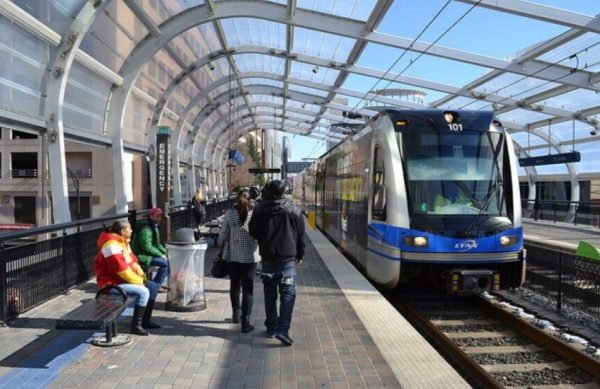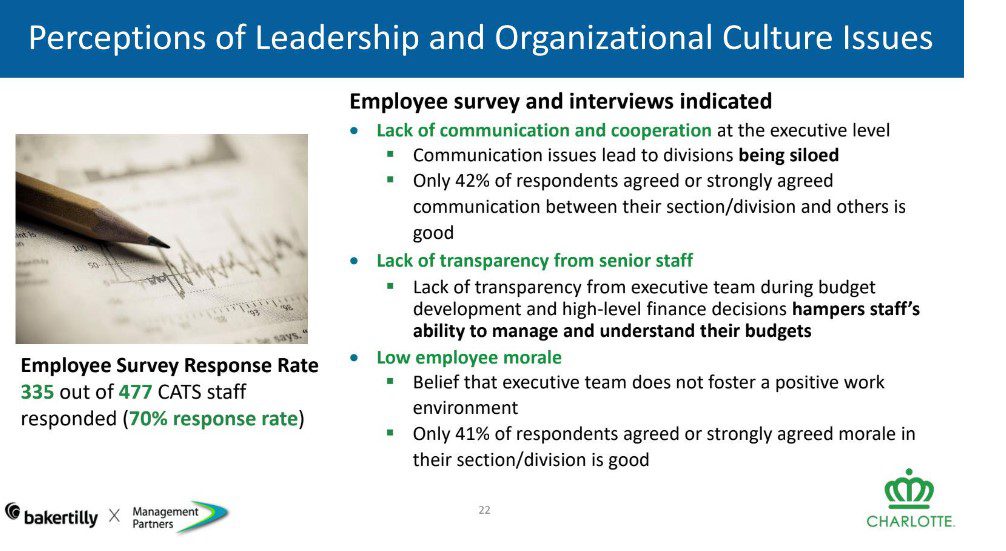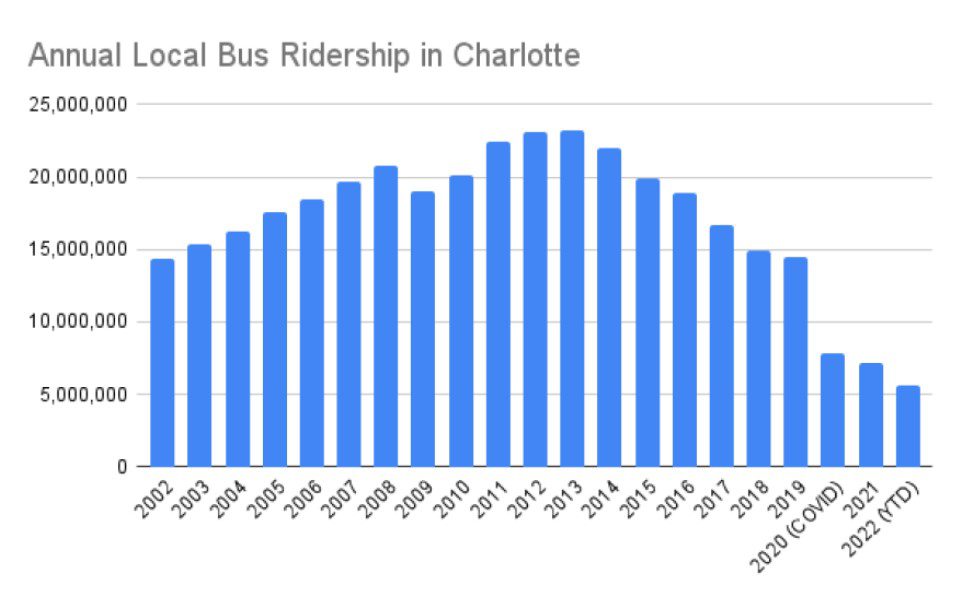Consultant’s report suggests changes in governance, budgeting, transparency

The Charlotte Area Transit System’s governance and organizational structure need a major overhaul, according to a consultant hired to review the city’s transit agency.
That consultant, Management Partners, found that CATS has unclear goals, departments that compete instead of cooperate, and a lack of transparency about its budget. The agency’s overall governance structure, which includes up to 13 positions reporting to the CEO and two separate-but-overlapping boards that oversee different parts of the organization, is also confusing, unwieldy and needs to be changed, the report found.
“Lack of engagement and transparency was cited quite a bit, especially around how CATS formulates or sets its operating budget from year to year,” said interim CATS Chief Executive Officer Brent Cagle, speaking at a virtual press conference held Dec. 23, the Friday before Christmas, about the report, which was dated Dec. 12. “We have to create a shared vision and really create a team that is collaborative, that works together, that isn’t sort of a rivalry or an adversarial relationship inside of the department … To the extent that that kind of culture exists, it has to stop.”
CATS experienced major leadership changes last year:
-
Chief Financial Officer Blanche Sherman resigned in December for a job in the private sector, a move Cagle said was not related to the review.
-
Former Chief Executive John Lewis resigned at the end of November.
-
Chief Operating Officer Allen Smith announced his retirement in October, then rescinded it in December.
Some of the recommended changes, like focusing on higher pay and more flexible working conditions to hire and retain employees, are things CATS is already working on, Cagle said. He also plans to streamline the agency’s organization and budgeting process. Other changes, like doing away with CATS’ system of being run by two separate boards, will require action from Charlotte City Council and possibly other legislative bodies.
“Staff is already working on many of the recommendations or are aware of those issues and determining how to best address them,” said Deputy City Manager Liz Babson.
CATS hired Management Partners in May to review the transit system’s leadership and organizational structure. Cagle said that contract was for $70,000. City officials said that a summary slideshow was the only report Management Partners produced, and no other records were provided to the city.
“There is not a report as we typically think about a report, which is a longer document with a lot of words,” Babson said. “There’s not more detail.”
Lewis, the former CATS CEO, left in November for a job as a consultant. His seven-year tenure was marked by efforts to improve the bus system and the opening of the Blue Line light rail extension and the Gold Line streetcar. But Lewis also dealt with a series of challenges and controversies, including unreliable streetcar and bus service, questions about transparency and declining ridership.
Lewis faced questions about issues such as whether a consultant working for a private developer on the central city’s bus station redevelopment was incorrectly presented as independent, and whether financing cost estimates for planned expansions were too rosy.
The biggest issue Lewis and CATS faced over the past year has been a bus driver shortage that made service unreliable, with buses that showed up late or not at all. Riders fumed, and CATS slashed service on many routes to try and make up for the shortage.

A report from an outside consultant revealed that CATS employees perceive a lack of communication and transparency from senior staff.
The city’s bus system is managed by a private contractor, RATP Dev. That company has tried and failed three times to reach a new agreement with the bus driver’s union. Negotiations are ongoing.Managing growth and decline
CATS is in the midst of a tricky balancing act: trying to bring the system back from years of pandemic-accelerated declines, while at the same trying to secure the funding for an ambitious $13.5 billion expansion plan centered around a new east-west light rail line.
Over the past year, tensions built between Lewis and some members of Charlotte City Council, especially Republican Tariq Bokhari, who called for Lewis’ ouster and said he wouldn’t support any new CATS expansions while Lewis remained in place.
Cagle, an assistant city manager and the former Charlotte Douglas International Airport director, is leading CATS on an interim basis until a permanent replacement for Lewis is found.
Like all transit systems, CATS saw ridership plunge during the pandemic. But CATS has been losing bus riders for years, with a bus system that isn’t frequent or reliable enough to get most riders where they want to go. The average one-way bus trip takes 90 minutes, officials have said. Attempts to realign the system with more crosstown routes and more frequent buses on some of the busiest lines haven’t worked out.

Since its peak in 2013, CATS has lost more than 75% of bus riders. And the trend shows no sign of stopping, even as the pandemic abates. Through mid-December 2022, CATS’ overall ridership was at 49% of its pre-pandemic levels. But rail ridership was up 87%, while bus ridership fell — down 10% in 2022, according to the report.
Bus ridership is at 43% of its pre-pandemic levels, well below the national average of 60%. Still, Management Partners said they did not uncover any “major operational issues” during their review.
“Perceptions about service (especially buses) is growing worse,” Management Partners noted in their report.
‘A bit unmanageable’
Many of the report’s specific findings centered on how CATS is organized and run. Those findings include:
-
With more than a dozen direct reports, the CEO’s “span of control” in the CATS organizational chart is too large for one person to effectively manage. “It’s a bit unmanageable,” Cagle said.
-
CATS reports to two boards: the Metropolitan Transit Commission, which is made up of local elected officials and is supposed to set the broader policy and strategy; and Charlotte City Council, which sets the agency’s budget. Some members serve on both boards. While the MTC can fire the CATS chief executive, the CATS chief executive reports to Charlotte’s city manager — who can be hired or fired only by City Council. The overall effect is to create a confusing overlap of responsibilities. “The current governance and reporting structure needs real change … Having two major policy bodies (MTC and City Council) and a CEO who reports to the City Manager can lead to confusion about decision making authority,” the review found.
-
Because CATS’ bus drivers technically work for a private contractor (RATP Dev) and aren’t city employees, there’s confusion around their role. “Contract bus drivers who walk and talk like City employees is an unusual arrangement … Bus operators do not always hear a consistent message,” the review says. Management Partners recommended contract employees no longer get city uniforms or email addresses and said the city should monitor only the contractor’s performance, not provide “operational direction.” That could represent a major change for Charlotte’s bus system, essentially turning over control to a private company. Cagle said CATS will spend the next year or so evaluating proposals from companies to run its bus system.
-
Partly because budget and policy decisions go through two separate boards, it can take up to a year for budgets to be finalized. That means CATS departments often don’t know what will be funded, and with how much, until they’re well into the fiscal year. And Cagle said departments don’t get feedback about why their budget requests are approved or not, meaning they can’t figure out what the organization’s priorities are. “Lack of transparency from executive team during budget development and high-level finance decisions hampers staff’s ability to manage and understand their budgets,” wrote Management Partners. Cagle said: “That creates the rivalry … they really literally just didn’t understand what would be funded until the budget was published.”
-
Low morale is an issue: 355 out of 477 CATS staff members responded to a survey from Management Partners, and only 41% said they agree morale is good.
-
CATS’ overall vacancy rate is 17%. “(The) inability to fill vacancies is having a real impact,” Management Partners noted.
Ely Portillo is senior editor for news and planning at WFAE, Charlotte’s NPR news source. He was previously with the UNC Charlotte Urban Institute and spent a decade as a reporter at The Charlotte Observer. Reach him at eportillo@wfae.org.
Go deeper: Read the consultant’s report for yourself
In brief…
-
In reversal, CATS projects more riders on edges-of-uptown light rail route: The City Council’s transportation committee voted unanimously to recommend building the Silver Line light rail around uptown, through Fourth Ward, rather than having it go through the heart of the center city. Charlotte Area Transit System officials presented revised projected ridership numbers on Tuesday that showed the route around uptown carrying more passengers than the middle-of-uptown route — a reversal of projections from last summer. CATS officials denied they altered ridership projections to support their preferred route: “We are following the facts wherever they took us,” said Andy Mock, the senior project manager for the Silver Line. (WFAE)
-
Underground bus station supported: The City Council’s transportation committee voted to support building a new uptown bus station underground, at a cost of about $90 million. It would be on the site of the current Charlotte Transportation Center and be below offices, a hotel, retail and possibly a new practice facility for the Charlotte Hornets. (WFAE)
This story was originally published as part of the Transit Time newsletter, jointly produced by WFAE and the Charlotte Ledger.
Ely Portillo, WFAE